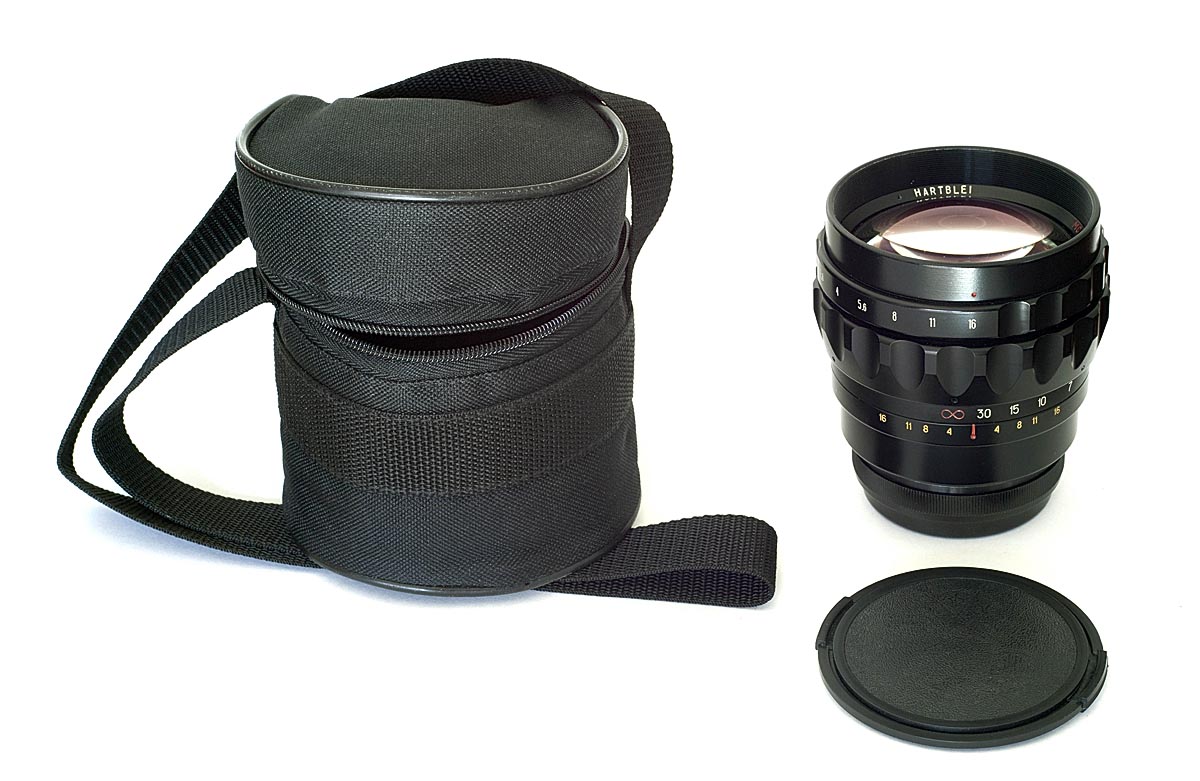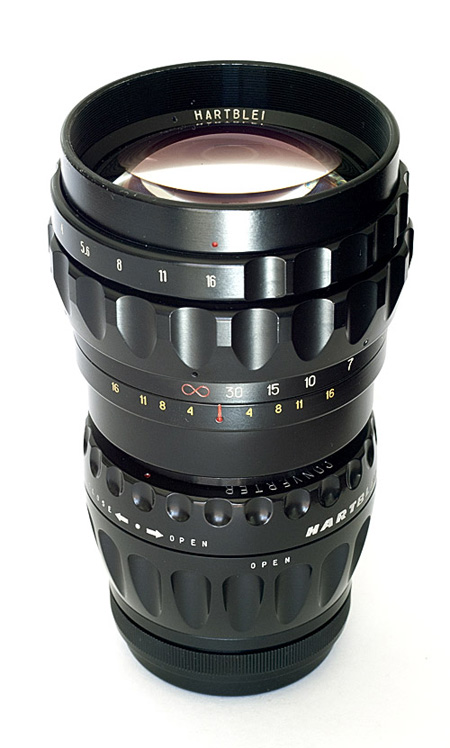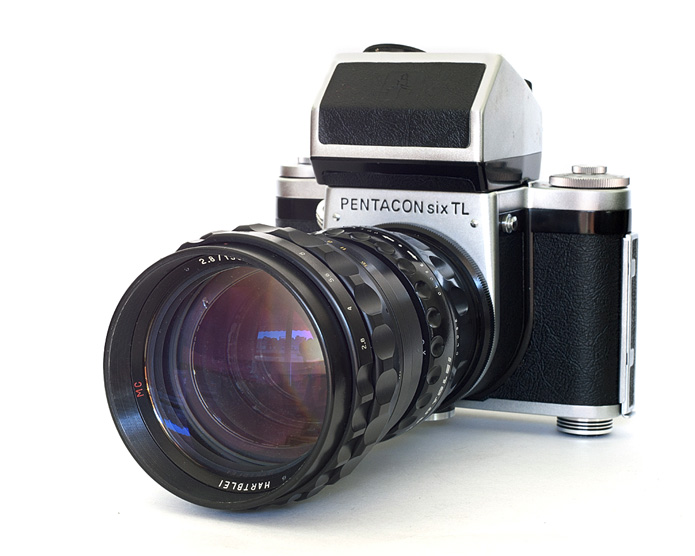
The 150mm Hartblei is supplied in soft black
padded nylon case, with space for filters in the lid
(although no filters were supplied with the lens
that I received from its previous owner).
[htbl150_1.jpg]
First Impressions of the 150mm Hartblei lens
At the end of the 1990s and the beginning of this century a company or companies called Hartblei produced a number of lenses that were based on the optical elements manufactured by Arsenal in Kiev, Ukraine for Medium Format camera lenses.
The first impression of Hartblei equipment is that it is better than the equipment of the Former Soviet Union (“FSU”), but still way behind the standards of Carl Zeiss Jena and Schneider-Kreuznach.

The 150mm Hartblei is supplied in soft black
padded nylon case, with space for filters in the lid
(although no filters were supplied with the lens
that I received from its previous owner).
[htbl150_1.jpg]
Like the 150mm Kaleinar/ARSAT lens whose optical elements it uses, the Hartblei 150mm MC lens focuses from infinity to 1.8m and has an aperture ring that has détentes at half-stop intervals from f/2.8 to f/16.
It has
But:
| 1. | 150mm is considered by many as an excellent focal length for portraits with medium format cameras. Unfortunately, the Kaleinar/ARSAT does not focus closely enough to allow a tight crop of the human head. This is a major shortcoming for a portrait lens and it is to be regretted that the Hartblei version did not rectify this defect. (One can of course improve close focus by using a short extension tube, which can work well in a portrait session, so long as one remembers to remove the tube afterwards, as with it in place the lens will of course not focus to infinity.) |
| 2. | Non-implementation of the full Pentacon/Carl Zeiss Jena specification or tolerances means that most of the time the lens does not open to full aperture, because the FAD (fully-automatic diaphragm) pin is too short, so even though the lever in the camera throat presses the pin in, it does not go far enough to open the lens fully. To all intents and purposes, therefore, the lens has a maximum working aperture of f/3.5 or even f/4, for focussing purposes. It only opens fully to f/2.8 if you are actually shooting at that aperture, which will be rarely. |
| 3. | There is no DOF (depth-of-field) lever – so stop-down metering with a Pentacon Six or Exakta 66 is difficult and in most circumstances impractical. It also means of course that you can’t check the depth of field, unless you are using a Kiev 60, which has a DOF lever built into the camera body. |
| 4. | The rear lens cap is too shallow and presses on the aperture pin, resulting in permanent pressure on the aperture spring whenever the lens is stored off the camera. This can only be harmful. Even the newer rear lens caps from the FSU have very nearly solved this problem by being deeper. |
| 5. | No lens shade (hood) was provided with the lens – although the filter size is the same as on the 150mm Kaleinar or Arsat lens (82mm), and so the lens shade from that lens can be used, if you can find one – they are extremely scarce! |
| 6. | The inside of barrel (which is of course black) has been scratched during manufacture or assembly, revealing bright metal marks between the elements. These must risk reducing contrast or degrading the image in other ways. |
You can read a review of the performance of the 150mm Arsenal Kaleinar lens here.
In conclusion, it seems to me that at the end of
the 1990s and the beginning of the 21st century in the areas of
both design and manufacture, Hartblei and its staff had not yet
overcome the mind-set of 70+ years of communism. The known
defects of the Kaleinar should have been designed out, and
scratched components should never have been included when
assembling a lens. This is not a question of quality
control after the lens has been assembled, but of the standards
required during assembly by all staff.
| Use with
the Hartblei 2× converter Stylistically, the Hartblei 150mm lens looks very attractive when combined with the Hartblei 2× converter, and the combination yields a 300mm lens with an effective maximum aperture of f/5.6, which is definitely usable, at least outdoors, although you are likely to want to stop down to an effective f/8 or f/11 (i.e., f/4 or f/5.6 on the lens), in order to improve sharpness. This combination is 154 mm long and weighs 1554g, shorter and lighter than the 300mm f/4 Carl Zeiss Sonnar, which has a minimum length of 224mm and weighs 2070g. (A new version of the 300mm Sonnar produced from approximately 1981 onwards is 204mm long and weighs 1550g.) While results with the Hartblei lens and converter are not likely to be on a par with those from the superb Zeiss lens, with the lens stopped down in many cases they are likely to be very acceptable and at normal degrees of enlargement may often be indistinguishible in quality from those with the Sonnar lens. Minimum
focussing distance One of the limitations of the 150mm Kaleinar (and Hartblei!) is that the minimum focussing distance is 1.8m, not close enough for head-and-shoulders shots, a serious flaw in the design of a lens with a focal length suitable for portrait photography, in my opinion. Using a 2× converter will not reduce the minimum focussing distance, but it won’t increase it either, so in many situations the result is more than acceptable, as half of the width/height of the subject is included in the image area at the same distance. Also, for what is effectively equivalent to a 300mm lens, a minimum focussing distance of 1.8m is extremely close. For comparison purposes, the minimum focussing distance of the Carl Zeiss Jena Sonnar is 4 meters. Here are the results of using the 150mm
Kaleinar, which is optically identical to the 150mm
Hartblei lens (apart from the lens coating), along
with the Arsenal 2× converter: 240_300mm.htm I decided to take a 150mm lens with me on a trip to Italy, and initially intended to take this lens with me. It is, after all, finished to a much higher standard than the normal Arsenal Kiev Kaleinar lens on which it is based. However, it is also significantly larger than the Kaleinar and heavier. Everything was going to go into a carry-on rucksack, with a Pentacon Six with 80mm lens and metering prism, the 45mm Mir-69 compact wide-angle lens, films for the trip and a Hasselblad XPAN with three lenses. The greater weight and size of this Hartblei lens was decisive: it got left behind, and I took the Kaleinar, instead. On a different trip, without the XPAN and its lenses, I would no doubt be delighted to take this beautiful lens and its matching 2× converter – although the lack of an aperture stop-down lever on this lens might mean that I would instead go for the only slightly heavier and larger Carl Zeiss Jena 180mm Sonnar. You can see a picture taken on that trip with the
Kaleinar here. The 150mm Hartblei lens
with the 2× converter from the same company
|
 [htbl150+2.jpg] |

The 150mm Hartblei and the Hartblei 2× converter
mounted on a Pentacon Six
[htbl150+2_2.jpg]
See more information on the Hartblei 2× converter here.
To go on to the information on Hartblei and Arsat
shift lenses, click here.
To go back to the beginning of the Lens Data
section, click below and then choose the range of lenses that
you want to read about.
Back to beginning of the
Lens Data section
To go back to the beginning of the lens tests,
click below and then choose the focal length that you want to
read about.
Back to beginning of lens
tests
© TRA December 2012, Latest revision: October 2017